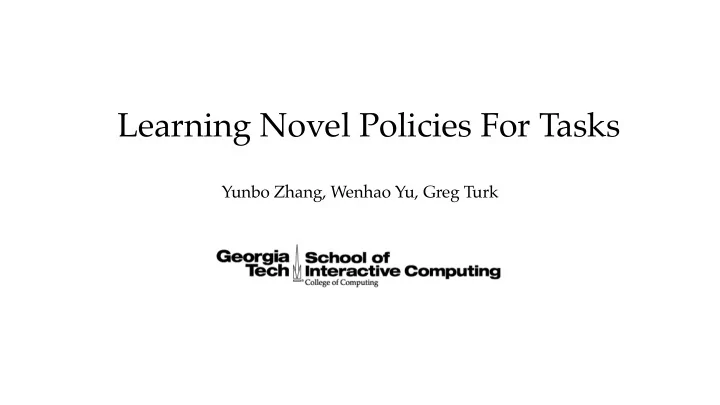

Learning Novel Policies For Tasks Yunbo Zhang, Wenhao Yu, Greg Turk
Motivation • Want more than one solution (i.e. novel solutions) to a problem. • E.g. Different Locomotion styles for legged robots. Style 1 Style 2 Style 3
Key Aspects • Novelty measurement function • Measures the novelty of a trajectory compared with trajectories from other policies • Policy Gradient Update • Make sure final gradient compromises between task and novelty • Task-Novelty Bisector (TNB)
Method Overview • Define a separate novelty reward function apart from task reward. • Train a policy using Task-Novelty Bisector (TNB) to balance the optimization of task and novelty. • Update novelty measurement function. • Repeat
Novelty Measurement • Use autoencoder reconstruction error of state sequences to compute novelty. • One autoencoder for each policy. • For the set of autoencoders 𝑬 = {𝐸 % , … , 𝐸 ( } , the novelty reward function is: 𝐸 < 𝒕 − 𝒕 > ) 9∈𝑬 ‖ ‖ 𝑠 +,-./ = −exp (−𝑥 +,-./ min
Task-Novelty Bisector (TNB) • Compute policy gradients for task reward and novelty reward ABCD = 𝜖𝐾 ABCD +,-./ = 𝜖𝐾 +,-./ 𝜖𝜄 𝜖𝜄 • Compute the final policy gradient using the following rules: or
Multiple Solutions PPO Policy End-Effector Target
Multiple Solutions TNB Policies
Deceptive Reward Problems • Our methods could be further extended to solve tasks with deceptive reward signals. • E.g. Deceptive Reacher Target End-Effector
Deceptive Reward Problems TNB Policies
Thank You! Poster: Pacific Ballroom #37
Recommend
More recommend